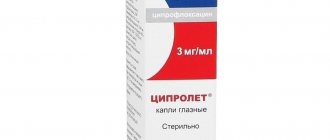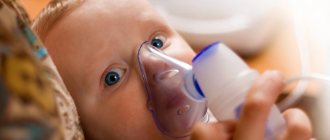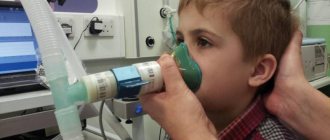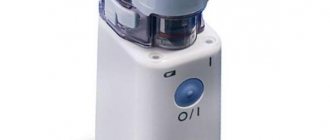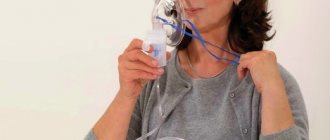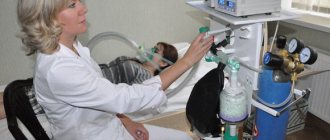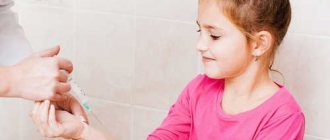Green snot in a child: reasons, how and how to treat such a runny nose?
Colds in children are accompanied by a runny nose.
Often, nasal discharge is colorless, liquid or viscous, which indicates a viral or allergic etiology of the disease. What does green snot mean? This means that there is an infection with bacterial flora. Green coloring of snot occurs due to the capture of bacteria and their waste products by neutrophils (phagocytes of the immune system), which are then destroyed and release the enzyme myeloperoxidase produced by lysosomes.
This enzyme has a good bactericidal effect, which inhibits the action of infectious agents in the early stages of the disease.
Causes of a runny nose with green mucus
Green snot in a child of any age appears due to a cold, rhinitis or laryngitis. Despite the fact that the etiology of the primary manifestations of the disease can be viral or allergic.
Under the influence of these factors, the protective functions of the nasal cavity weaken, favorable conditions for the appearance of a bacterial infection appear, and previously transparent and liquid discharge becomes green.
The most common reasons for the appearance of green snot in a child in the first year of life include:
- irritable reaction to dust, wool, powders with which the child comes into contact;
- viral infections followed by bacterial damage. Viruses entering the nasal or oral cavity provoke the mucous membrane to intensify the production of secretions, which leads to its stagnation. Because of this, the movement of mucus decreases, bacteria enter it, with subsequent reproduction;
- greenish mucus with an odor is often a manifestation of a foreign body present in the nasal cavity. Snot flows from one nostril and may contain reddish or light brown streaks, which indicates the presence of pus.
In a child from 2 to 5 years old, the appearance of green snot often appears after:
- contact with other children (on the playground, at a party or in kindergarten);
- The appearance of green snot in children of this age is a normal reaction to vaccinations, and a rare rash may appear on the skin or face.
Risk factor - contact with other children
If, against the background of a generally healthy condition, such snot appears in a child 5 years of age or older, it is necessary to go to the clinic for examination. Possible reasons for their appearance may be:
- previously untreated rhinitis;
- contact with a sick child in kindergarten, school or on the playground;
- the possibility of the presence of a foreign body cannot be excluded;
- the first manifestations of an allergic reaction or cold;
- constant presence in a closed, poorly ventilated room, rare walks in the fresh air.
Curing green snot is not a problem for parents, but an irresponsible attitude can significantly aggravate the situation.
Possible complications
The reasons for the appearance of complications of bacterial rhinitis, in which thick green snot is released, are due to the incompetence of the parents. They try to cure the child using “grandmother’s” methods, after which the condition may worsen.
Important! You need to remember that under no circumstances should you instill breast milk, urine, alcohol solutions and infusions into the nasal cavity. These methods will not help your child in any way; they weaken the protective functions of the mucous membrane, which can accelerate the growth of a bacterial infection.
The main group of complications of a runny nose with green snot includes:
- sinusitis is an inflammatory disease of the maxillary (maxillary) sinuses, accompanied by headache, aggravated by bending over, irritability, and constant nasal congestion. Discharge from sinusitis is scanty and viscous. If treatment is not timely, a purulent process may develop, which is complicated by meningitis or encephalitis;
- frontal sinusitis and ethmoiditis - the inflammatory process is located in the sinuses of the frontal and ethmoid bones. In most cases, the causes of the appearance of the inflammatory process in this localization are represented by the addition of streptococcal and staphylococcal flora. The progression of this condition is accompanied by the release of a large amount of pus, destruction of mucous tissue and bones;
- otitis - in the nasopharynx there are two passages leading into the middle ear cavity. They serve to normalize the pressure in it. Often, during infectious processes of the nose or pharynx, pathogenic microflora through these passages will enter the ear, provoking the occurrence of an inflammatory process in it. This condition is more typical for children over 6 years of age. If there is an inflammatory process in the ear, the child complains of pain in it, a feeling of fullness, due to a significant increase in pain, bending becomes impossible. Without appropriate treatment, the child gradually loses hearing (the auditory nerve is involved in the process);
- meningitis and encephalitis - most often appear after the onset of ethmoiditis or sinusitis of another localization. This complication threatens the child’s life. When the first symptoms appear, namely: headache, convulsions, head thrown back, difficulty bending the head forward, you must urgently seek medical help;
- Thrombosis of the cavernous sinus is the most serious complication, leading to the rapid death of the patient if treatment is not started in a timely manner. It manifests itself as severe headache, high body temperature (up to 40 degrees), rapid onset of coma, the appearance of a hematoma under one or both eyes, and protrusion of the eyes.
Do not panic at the first appearance of green snot in your child and stuff him with antibiotics. These actions will lead to the emergence of bacterial resistance to these drugs and a significant deterioration in their effectiveness with subsequent occurrences of pathology.
It is necessary to figure out why the child has green snot and what contributed to its appearance. If any difficulties arise, you should consult a pediatrician.
He will help you figure out what caused them and how to get rid of green snot at home.
How and how to treat green snot in children?
Treatment of green snot consists of determining the cause of its appearance and applying the most effective method to eliminate this cause. A qualified specialist will help you figure this out.
He will collect all the necessary information about the child, his place of residence, his diet, conduct an examination and take materials for bacteriological culture. This will make it possible to determine the pathogen and its sensitivity to antibiotic therapy. After this, he will write out recommendations for treatment.
Doctors say that the frequent appearance of green snot in a child under 3 years of age indicates an improper regimen and care for the child, and the first thing they do is correct it.
Pharmacy products
If there is a mild form of the disease, then therapy is limited to the use of topical drugs, improving the passage of mucus in the nasal cavity and clearing it of snot.
Snot from a one-year-old child is removed using a syringe or syringe (after removing the needle), washed with saline solutions (drop two or three drops into each nasal passage). During the first attempts at treatment, the child may begin to cough, cry, or vomit, but do not be alarmed.
If the child is 1 year old, Vibrocil can be used as a vasoconstrictor therapy. It will relieve swelling of the mucous membrane and help get rid of snot in a short time. It is allowed to instill 1 drop into each nostril no more than four times a day.
If such treatment does not bring positive results within 5 days, you should consult a doctor.
"Vibrocil" will help relieve inflammatory swelling and improve mucus passage.
“Polydexa” is an effective remedy, the action of which is aimed at reducing swelling of the mucous membrane, quickly removes dark, green thick snot, and has a wide antibacterial spectrum of action.
Polydexa contains two antibacterial substances - neomycin sulfate and polymyxin B sulfate. They are destructive to most pathogens of bacterial infection.
If the child does not show positive dynamics during the therapy, the snot becomes thicker, brown streaks are added, and a foul odor appears, then the use of antibacterial drugs is allowed. For children under 3 years of age, it is recommended to use drugs in the form of suspensions (Sumamed, Macropen), in parallel with local ones (Polidexa, Bioparox, Isofra).
Inhalation with a nebulizer
If frequent attacks of coughing and shortness of breath occur, doctors recommend using inhalers. Inhalations for green snot in a child are carried out with an antibiotic solution to prevent the development of bronchitis or pneumonia, as well as to increase the effect against the background of general therapy. The solution can be used after consultation with your doctor.
Recipe for inhalation solution: “Fluimucil” - dosage for children no more than 125 mg, per session. Stir the dry substance in 1 ml of solution for injection, spraying the drug with a nebulizer.
The child must be explained what to do when the nebulizer is running, how to inhale and exhale correctly. Before treatment, it is necessary to clear the nasal passages if you need to instill vasoconstrictor drugs.
A child’s runny nose cannot be cured with a nebulizer, but with general drug therapy and attentive care, the treatment process will be significantly accelerated.
Steam inhalations
Folk remedies for treating a runny nose in a child also include steam inhalation. To prepare them, you need to boil water in a kettle or saucepan; for the best effect, add pine buds, eucalyptus essential oil, decoctions of sage, chamomile, black currant, and linden.
Warm steam, along with the beneficial substances of the additives, will help expand the pores in the nose, relieve inflammation, and remove swelling.
Before carrying out the procedure, it is necessary to explain to the child that they need to breathe alternately through the mouth and nose, the baby should not inhale the steam sharply and deeply, as a burn may develop.
Traditional methods
There is no need to think about the question “how to quickly cure a runny nose with green snot, using traditional medicine?”, since such methods, although they have the desired effect, for a quick recovery, they must be used in combination with other treatment options. Traditional medicine is widely used in the treatment of colds and runny nose, and it is also effective for the appearance of green snot.
Washing
The most famous folk method is rinsing the nose with saline solution. To prepare it, you need to take one spoon of sea salt and dilute it in one liter of boiled water. Before washing, be sure to cool the solution. To rinse your nose, you need to pour liquid into one nostril so that it flows out of the opposite. Repeat on both nostrils.
When using a syringe, control the water pressure - it should not be strong.
Rinsing a child's nose with a syringe
Folk oils
Folk remedies based on oils well strengthen the protective functions of the nasal mucosa.
To prepare oils, you need to grind the main substrate (leaves of aloe, wild rosemary, eucalyptus, Kalanchoe), strain through cheesecloth, add olive oil and leave for a while in a place inaccessible to sunlight.
Then the oil is filtered through gauze and the child’s nasal passages are moistened with it using cotton swabs. Before treating your child's green mucus with these medications, consult your doctor.
Decoctions
One of the best methods is to take decoctions of the leaves:
- calendula;
- chamomile;
- mint;
- St. John's wort;
- sage;
- eucalyptus.
They need to be taken orally, and the nasal passages must be washed before taking them.
Prevention
To avoid the appearance of green snot, you need to protect yourself from colds.
To do this, you need to spend more time in the fresh air, eat well, carry out immunoprophylactic measures, and take fortified medications. Hardening is suitable for older children.
Remember - you need to treat green snot in a child as soon as it appears and only under the supervision of a pediatrician. It is he who will tell you how to treat green snot without further complications.
Green snot in a child: reasons, how and how to treat such a runny nose? Link to main publication
Author of the publication: Tarasov Igor Vadimovich
Source: https://doctos.ru/np/zelenye-sopli-u-rebenka.html
Inhalations for green snot: when to use in children and adults
- 1 Inhalation with a nebulizer
- 2 Procedure
- 3 Solutions for inhalation
A runny nose accompanied by green snot indicates an infection of the respiratory tract.
This condition requires mandatory consultation with an otolaryngologist, especially if there is a tendency to develop sinusitis and in pediatric practice. Inhalations for green snot can be prescribed by a doctor at an early stage of the disease, without warming up.
An independent decision to carry out this procedure can have negative consequences.
Inhalation with a nebulizer
Whether it is possible to do inhalations with green snot, the doctor determines. Usually this procedure is welcome provided there is no heating. Such procedures promote rapid recovery and easier breathing.
Inhalation for green snot with a nebulizer is recommended twice a day for diseases of the respiratory system of any etiology. If you have a device, you can carry out the procedure yourself, without leaving your home.
Such inhalations allow the patient to eliminate the source of inflammation, reduce nasal congestion, and restore freedom of breathing and the sense of smell.
An inhaler for nasal congestion helps solve a number of problems that alleviate the patient’s condition, namely:
- moisturize the nasal mucosa that has been aggressively affected by infection;
- soften crusts formed in the nose;
- eliminate itching and burning that accompany this disease;
- improve secretion discharge due to its dilution;
- deliver the drug to the site of inflammation thanks to the fine dispersion;
- It is easily tolerated by people of all categories and is an absolutely painless procedure.
Inhalation for green snot in a child with a nebulizer is carried out using mineral water, herbal decoction or saline solution. When choosing a herbal decoction, you should take into account the tendency to an allergic reaction.
Mineral water is harmless and helps improve the discharge of accumulated exudate and moisturize the nasal mucosa. The doctor will determine what to use in each case.
Inhalations for green snot in a child should be carried out under the supervision of a specialist while monitoring the condition during and after the procedure.
The tendency to develop sinusitis in children is very high, so heating is not allowed, as it can accelerate the spread of infection and the formation of a focus of infection.
Before each procedure, the child must be examined by an otolaryngologist. Considering the prevalence of the pathological process, the doctor decides whether it is possible to do inhalation for green snot in a child or whether this carries a risk of complications of a more serious disease.
Progress of the procedure
Inhalations for a stuffy nose make breathing easier. The procedure should not be carried out immediately after eating and before going outside.
Inhalation time takes 10-15 minutes for adults and 7-10 minutes for young children. You should breathe calmly, talk, and distractions are not recommended. After the session, it is better to put drops into your nose and drink tea with honey.
How the nebulizer works
Progress of the procedure:
- Assemble the nebulizer, connect it to the power supply, fill in the selected substance for inhalation (as prescribed by the doctor).
- Wear an inhalation mask, the size is selected according to age (adult or child), the mask should fit snugly to the face.
- Breathe calmly for the specified time.
- After inhalation, lying down and vigorous physical activity are not immediately recommended.
Inhalations for severe nasal congestion are carried out after cleansing the nasal passages.
To increase the effectiveness of the procedure, it is necessary to breathe calmly and measuredly, inhale and exhale through the nose when carrying out the procedure for prevention. If there is severe nasal congestion, inhale through the nose and exhale through the mouth.
Whether it is possible to do inhalation with nasal congestion is decided by the otolaryngologist, especially in pediatric practice. High body temperature or the formation of a purulent focus does not allow the procedure to be performed; this can aggravate the condition and provoke serious complications.
Solutions for inhalation
To treat a runny nose in children, mineral water is most often used; in adults, herbal decoctions and special solutions are also used.
- Tonsilgon diluted with saline: 1:3 children under one year;
- 1:2 up to 6 years;
- 1:1 over 6.
Accepted for chronic and acute processes.
- Interferon is effective in cases of viral etiology of the disease; it is prepared in heated saline solution (3 ampoules) per procedure. In addition to being effective against viral infections, interferon stimulates natural immunity.
- Miramistin 0.1% is prescribed for the treatment of purulent snot in adults and children over 12 years of age.
- Alkaline solutions.
If you have frequent colds in your family, it makes sense to purchase a nebulizer for home use; the device will especially make treatment for children easier. Inhalation procedures bring relief after the first uses, are easy to use and do not cause discomfort.
The steam from the nebulizer is not hot, so it is safe if the child is fidgety. The choice of drug and the decision on inhalation treatment should always remain with the doctor; illiterate therapy or an error in diagnosis can harm health instead of the expected healing.
Source: https://gaimorit-sl.ru/mestnye-simptomy/sopli/ingalyatsii-pri-zelenyh-soplyah.html
Inhalations in children with green snot
Inhalation for green snot is a common way to prevent and treat sinusitis. The characteristic color of the mucus indicates infection of the nasal cavity by pathogens, which can easily lead to infection of the sinuses and the development of sinusitis in the patient.
Therefore, it is important to immediately take decisive action when green snot appears, especially in children. The child's body does not have a strong immune system and is often unable to cope with the growth of the source of infection. The task of parents is to provide all possible assistance to the child.
What is the advantage of inhalation therapy over other treatment methods? What do you need to know to most effectively influence the virus in the nasal cavity? Let's figure out how to do inhalation correctly in order to eliminate the infection without harming the child.
How do inhalations help with a runny nose?
The effect of drug vapor on the nasal mucosa can improve the patient's condition. If you have green snot, you cannot warm up the nasal cavity, as this causes accelerated development of the virus, especially in children. Therefore, the use of a nebulizer is considered more preferable. When inhaling drug vapors, the following processes occur in the nasopharynx:
- Complete hydration of the mucous membrane. The microflora is normalized, dried mucus softens and begins to leave the nasal passages naturally. As the nasal cavity is freed from mucus, the painful burning sensation disappears and breathing becomes more even.
- The drug is quickly and abundantly sprayed over the surface of the mucous membrane, covering the source of infection with a wide front. This becomes possible due to the finely dispersed structure of the mixture. The active components of the drug begin to fight infection over the entire spray area.
- With the correct selection of components for the inhaler, the procedure is safe for the body and does not cause complications. The vapors of the active substance are at room temperature and are safe for the patient’s respiratory system.
The use of the device is not justified in all cases. So, in patients who have elevated body temperature or nosebleeds, inhalation procedures are prohibited. Contraindications are tachycardia, high blood pressure and purulent discharge from the nasopharynx.
The decision to use inhalation therapy for a child is made by the attending physician. He will also recommend the components necessary for the nebulizer and carry out treatment.
Important! The first procedures can be carried out with cold steam. Then the temperature is increased for adults to 50 degrees, and for children - to 40.
How to do inhalation correctly?
It is better to carry out procedures under the supervision of medical staff. Treatment at the clinic includes the following steps:
- Conduct a preliminary examination with a doctor. The specialist will take cultures from the surface of the mucous membrane and find out which microorganisms cause the disease. Then he will select the optimal composition for inhalation, which has an active effect on this type of bacteria. The most popular herbs are thyme, linden, sage, eucalyptus, St. John's wort and oregano. The active drugs Tonsilgon, Miramistin and Interferon are also used in combination with saline.
- The choice of composition for inhalation usually includes saline solution and herbal extract. In this case, the individual allergic reactions of the patient’s body to the plant components used are taken into account in order to prevent the activation of inflammatory processes in the mucous membrane.
- Inhalation from green snot is carried out to a child twice a day for a duration of 7 to 15 minutes. After the procedure, you should avoid physical activity and try not to breathe cold air.
Important! For children, inhalations are given with saline solution or mineral water. Herbal infusions are used less frequently.
The nebulizer inhalation procedure is quite simple and can be easily performed at home. Therefore, if family members have a tendency to chronic runny nose, purchasing a nebulizer would be a reasonable solution. The procedure for this includes the following steps:
- Preparing the device for operation. Assembly, connection to the power supply, filling with composition for inhalation. It is important to keep the solution temperature to no more than 40 degrees when inhaling a child to prevent burns to the mucous membrane.
- Patient preparation. Children need to choose a tight-fitting mask and secure it on their face.
- The procedure assumes that the child breathes at a normal rhythm for 5–7 minutes. Then it is better to lie down for a while and avoid excessive physical activity.
The results of using the nebulizer visually appear a couple of days after inhalation. Breathing normalizes, snot becomes smaller, and turns yellow. Regular use of the device to prevent relapse allows you to forget about a runny nose.
How to do inhalations for green snot for children and adults
A runny nose accompanies colds, viral infections, allergic reactions, and is not an independent disease. When the immune system is strong and easily fights the disease, the snot goes away within 5–7 days.
When a runny nose drags on for a longer time and the discharge changes color, becomes yellow or green, we can talk about an inflammatory process that has begun to progress.
Green snot may indicate rapid growth of bacteria and the onset of sinusitis, so to prevent serious complications, consult an otolaryngologist.
If the inflammatory process has just begun, then at an early stage the doctor may recommend taking a course of inhalations, which will help improve nasal breathing and relieve swelling of the nasal mucosa.
For green snot, inhalation is often carried out using a nebulizer, but treatment can begin only after preliminary diagnosis.
Inhalations with a nebulizer for green snot
Using a nebulizer, the maximum effect of the procedure is achieved: the spraying of healing vapors penetrates deeply into all parts of the respiratory tract. Inhalations with a nebulizer for green snot and cough can solve the following problems: relieve the inflammatory process in the upper and lower parts of the respiratory system, moisturize the mucous membrane.
Thanks to the use of a nebulizer, the patient receives a certain dose of the drug, so this method of treatment is the most gentle for the mucous tract of the nasopharynx.
Currently, nebulizers use nebulas (containers) that contain the medicinal substance with a solvent. The volume of the containers is 5 ml. But, any medications for the nebulizer are selected only taking into account the age and condition of the patient.
If you do not know how to perform inhalations using a nebulizer, we recommend that you read the instructions in the video.
If green snot has just appeared, you can inhale it yourself only with saline solution.
Inhalation with saline solution for green snot
Herbal inhalations for green snot for a child
If the doctor gives the go-ahead for the use of inhalations, you can use decoctions and infusions of herbs, which also have a pronounced anti-inflammatory, anti-edematous, bactericidal and thinning effect.
For thick green snot, steam inhalations with decoctions and infusions of chamomile, calendula, thyme, linden, sage, eucalyptus, oregano, St. John's wort and other herbs are used. The temperature of the medicinal solution should not exceed 50 degrees, and for children - 40 degrees. A higher temperature of the medicinal product often leads to burns of the mucous membrane.
The following preparations are especially popular for inhalation of thick green snot:
Collection No. 1
Collection No. 2
Collection No. 3
All herbs are taken in equal parts. A tablespoon (10 grams) of the collection is poured with 300 ml of boiling water, left for 40 minutes, and used for all types of inhalations. The course of treatment is from 3 to 7 days.
Source: https://medrese-rt.ru/zabolevaniya-nosa/ingalyatsii-u-detej-pri-zelenyh-soplyah.html
Contraindications
In what cases is inhalation for green snot unacceptable? The procedure is not performed if cough and yellow nasal discharge in children are accompanied by high fever. The pediatrician will tell you how to treat your baby. High temperature is a dangerous condition for the health of the baby, so independent actions are unacceptable. In this case, you should lower your temperature and wait for the doctor to come to your home.
Is it possible to do steam inhalations if you have green snot and a strong cough? Do not use inhalations if the baby is agitated and restless. Intermittent and shallow breathing will prevent the penetration of healing substances along the back wall of the nasopharynx and do not expect any benefit from such treatment.
Do not perform inhalations if the baby becomes lethargic after them. This suggests that the body does not accept such therapeutic effects. The child may become covered in perspiration and his bowel movements may change. Other signs may appear by which the mother will determine that the procedure is no longer necessary.
Similar articles
Recipes for inhalation with a nebulizer for a runny nose
Inhalations for ARVI
The effectiveness of soda inhalation for lung cancer
Inhalations and breastfeeding - how to cure a cold
( 1 ratings, average: 5.00 out of 5)
Cough and runny nose inhaler for infants
Previous article
Tonsilgon for inhalation for colds for children and adults
Next article
Advertisements
Inhalations for green snot in a child: is it possible to do?
A runny nose accompanied by green snot indicates an infection of the respiratory tract.
This condition requires mandatory consultation with an otolaryngologist, especially if there is a tendency to develop sinusitis and in pediatric practice.
Inhalations for green snot can be prescribed by a doctor at an early stage of the disease, without warming up. An independent decision to carry out this procedure can have negative consequences.
Inhalation with a nebulizer for green snot in a baby
Inhalations for snot in a small child help with rapid healing. The evaporation of healing substances using a nebulizer penetrates the walls of the affected mucosa and has an analgesic, antimicrobial and healing effect.
Inhalations with a nebulizer for green snot help to cleanse the mucous membrane and eliminate the infection, the product of which is purulent discharge.
How are inhalation procedures performed for children, what composition is used to treat snot? Let's look at it in the article.
Nebulizer
This type of inhaler has become widespread due to its convenient design and ease of use.
The device consists of containers for liquid, a working part and attachments - a mask, a tube. The prepared medicinal solution is poured into a container, a mask is put on and the device is plugged in.
The patient inhales the fumes from the heated liquid through the nose or mouth.
In this state, the healing components easily penetrate the mucous membrane without being absorbed into the blood, and have a therapeutic effect only on the area affected by microbes.
This is the main difference between inhalation procedures and treatment with tablets.
Inhalations are allowed to treat babies from birth because they are completely safe and have a targeted effect.
Inhalation in a nebulizer can be done for a sleeping child - for this, purchase an ultrasonic silent device.
However, before use, you need to consult a pediatrician to find out the nuances of preparing the medicinal composition and the correct dosage.
Runny nose in a child
If a toddler has green snot, it means that bacteria are actively multiplying in the body. The products of their vital activity can be identified by color - yellow, green.
To eliminate the proliferation of microorganisms, you need to inhale medicinal compounds that suppress their activity. The recipe for the composition will be indicated by the pediatrician; you cannot independently prescribe treatment for snot with an inhaler for a child.
The pediatrician will indicate the time of inhalation, the correct composition for green snot and treatment for cough. The action of different microbes is eliminated with different medicinal substances, which the mother does not know about.
Therefore, treat your baby only after consulting a doctor.
At the beginning of the disease, the child starts to leak clear mucus from the nasal passages; with strong immune protection, the runny nose can go away in a few days.
However, if the runny nose persists and the color of the discharge changes, this may indicate a purulent-inflammatory process. Mom notices that the nasal discharge turns yellow, and then instead of yellow snot flows green.
This process can result in sinusitis and otitis media, so start treatment immediately.
Green nasal discharge
How to do inhalations for children with green snot? Before the pediatrician’s visit, procedures are performed only with saline solution or non-carbonated mineral water.
When green discharge first appears, moisturizing the nasal passages and clearing mucus will ease the baby’s condition - the child will be able to breathe through his nose.
Yellow discharge can also be eliminated by inhaling a sprayed saline solution.
If the discharge is yellow or green and thick, the inhalation composition is made from medicinal herbs with bactericidal properties:
- chamomile;
- eucalyptus;
- sage;
- St. John's wort;
- other.
To prevent hot steam from burning the mucous membrane, you need to monitor the temperature of the healing composition. For adults, inhalations for green snot are done at a temperature of about 50 degrees; for children, the temperature should not exceed 40 degrees. Some inhalations are carried out at 30 degrees.
How to prepare a healing herbal solution if we treat thick snot in children by inhalation? To do this, take dry herbs in equal proportions (for example, a pinch of each) and mix. Then a tablespoon of the finished mixture is steamed with boiling water (a cup) and allowed to stand under the lid for 40-45 minutes.
When treating, pay attention to the baby’s condition - some children cannot tolerate the procedure and actively resist the effects of inhalation and the inhaler. It is impossible to cure such babies with snot with a nebulizer.
Contraindications
In what cases is inhalation for green snot unacceptable? The procedure is not performed if cough and yellow nasal discharge in children are accompanied by high fever.
The pediatrician will tell you how to treat your baby. High temperature is a dangerous condition for the health of the baby, so independent actions are unacceptable.
In this case, you should lower your temperature and wait for the doctor to come to your home.
Is it possible to do steam inhalations if you have green snot and a strong cough? Do not use inhalations if the baby is agitated and restless.
Intermittent and shallow breathing will prevent the penetration of healing substances along the back wall of the nasopharynx and do not expect any benefit from such treatment.
Do not perform inhalations if the baby becomes lethargic after them. This suggests that the body does not accept such therapeutic effects.
The child may become covered in perspiration and his bowel movements may change.
Other signs may appear by which the mother will determine that the procedure is no longer necessary.
(15,00
Source: https://qlor.ru/ingaljacii-pri-zelenyh-sopljah-u-rebenka-mozhno-li-delat.html
Green nasal discharge
How to do inhalations for children with green snot? Before the pediatrician’s visit, procedures are performed only with saline solution or non-carbonated mineral water. When green discharge first appears, moisturizing the nasal passages and clearing mucus will ease the baby’s condition - the child will be able to breathe through his nose. Yellow discharge can also be eliminated by inhaling a sprayed saline solution.
Important! Inhalations for green snot are carried out using herbal medicinal compounds.
If the discharge is yellow or green and thick, the inhalation composition is made from medicinal herbs with bactericidal properties:
- chamomile;
- eucalyptus;
- sage;
- St. John's wort;
- other.
To prevent hot steam from burning the mucous membrane, you need to monitor the temperature of the healing composition. For adults, inhalations for green snot are done at a temperature of about 50 degrees; for children, the temperature should not exceed 40 degrees. Some inhalations are carried out at 30 degrees.
How to prepare a healing herbal solution if we treat thick snot in children by inhalation? To do this, take dry herbs in equal proportions (for example, a pinch of each) and mix. Then a tablespoon of the finished mixture is steamed with boiling water (a cup) and allowed to stand under the lid for 40-45 minutes.
Inhalations for green snot in a child are done daily, but no more than seven days in a row. When treating, pay attention to the baby’s condition - some children cannot tolerate the procedure and actively resist the effects of inhalation and the inhaler. It is impossible to cure such babies with snot with a nebulizer.
Inhalation for green snot in a child with a nebulizer: how to do it
Inhalation for green snot is a common way to prevent and treat sinusitis. The characteristic color of the mucus indicates infection of the nasal cavity by pathogens, which can easily lead to infection of the sinuses and the development of sinusitis in the patient.
Therefore, it is important to immediately take decisive action when green snot appears, especially in children. The child's body does not have a strong immune system and is often unable to cope with the growth of the source of infection. The task of parents is to provide all possible assistance to the child.
What is the advantage of inhalation therapy over other treatment methods? What do you need to know to most effectively influence the virus in the nasal cavity? Let's figure out how to do inhalation correctly in order to eliminate the infection without harming the child.
Runny nose in a child
If a toddler has green snot, it means that bacteria are actively multiplying in the body.
The products of their vital activity can be identified by color - yellow, green. To eliminate the proliferation of microorganisms, you need to inhale medicinal compounds that suppress their activity. The recipe for the composition will be indicated by the pediatrician; you cannot independently prescribe treatment for snot with an inhaler for a child. At the beginning of the disease, the child starts to leak clear mucus from the nasal passages; with strong immune protection, the runny nose can go away in a few days. However, if the runny nose persists and the color of the discharge changes, this may indicate a purulent-inflammatory process. Mom notices that the nasal discharge turns yellow, and then instead of yellow snot flows green. This process can result in sinusitis and otitis media, so start treatment immediately.
Inhalations for green snot in a child are performed with great care, and only after consultation with a pediatric ENT specialist. Most often, children with green snot are inhaled using saline, medicinal herbs and medications suggested by the doctor. There should be no amateur activity when treating green snot in children.
In childhood, lingering snot often turns into sinusitis than in adults. Therefore, the main thing is not to harm the baby and not to “overheat” the infected mucous membrane.
The duration of all inhalations in children should not exceed 5 minutes, and the temperature of the solutions should be maintained within 40 degrees.
Uncontrolled heating of the nasal sinuses with the presence of green snot often leads to a hospital bed, a long course of antibacterial therapy and surgical treatment. Remember, a prolonged runny nose with green snot can only be treated under the supervision of an otolaryngologist.
How to perform inhalations for children
